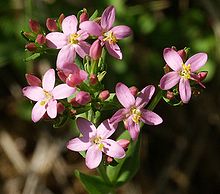- Centaurium erythraea
-
Centaurium erythraea 
Scientific classification Kingdom: Plantae (unranked): Angiosperms (unranked): Eudicots (unranked): Asterids Order: Gentianales Family: Gentianaceae Genus: Centaurium Species: C. erythraea Binomial name Centaurium erythraea
RafnSynonyms Erythraea centaurium
Centaurium minus
Centaurium umbellatumCentaurium erythraea is a species of flowering plant in the gentian family known by the common names common centaury and European centaury. This centaury is a widespread plant of Europe and parts of western Asia and northern Africa. It has also naturalised in parts of North America and throughout eastern Australia, where it is an introduced species. This is an erect biennial herb which reaches half a meter in height. It grows from a small basal rosette and bolts a leafy, erect stem which may branch. The triangular leaves are arranged oppositely on the stem and the erect inflorescences emerge from the stem and grow parallel to it, sometimes tangling with the foliage. Each inflorescence may contain many flowers. The petite flower is pinkish-lavender and about a centimeter across, flat-faced with yellow anthers. The fruit is a cylindrical capsule.
It flowers from June until September.
The European centaury is used as a medical herb in many parts of Europe.The herb, mainly prepared as tea, is thought to posses medical properties benefical for patients with gastric and liver diseases.It is also a powereful antioxidant.The active ingridients of the centaury are mainly phenolic acids[1] as ferulic and sinapic acids.The plant also contains amounts of sterols as brassicasterol and stigmasterol[2].
External links

This Gentianales-related article is a stub. You can help Wikipedia by expanding it.
